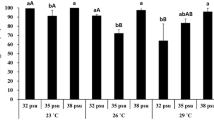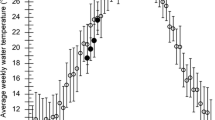Abstract
Female mud crabs, Rhithropanopeus harrisii, carrying newly extruded eggs, were collected from the Petaluma River (San Francisco Bay Estuarine System, California, USA) in summer 1985, and exposed to factorial combinations of temperature (20°, 25° or 30°C) and salinity (2, 5, 15, 25, or 32%.). Upon hatching, dry weights of 12 to 15 h-old zoeae were determined. Subgroups of the remaining zoeae were transferred from hatching salinities to the salinities listed above and raised until metamorphosis to megalopa. Low salinities reduced zoeal dry weights by as much as 25%. Temperature played a secondary role in reduction of hatching weight of zoeae. Survival of larvae through zoeal development was best when hatching and rearing salinities were the same; in this case, overall survival increased with temperature. Both duration of zoeal development and megalopal dry weights were strongly influenced by temperature and rearing salinity, with only a small contribution from hatching salinity. The influence of hatching salinity was most obvious at extremes of the range tested. These studies indicate that physical conditions during embryogenesis profoundly influence subsequent larval development. Interpretation of experimental approaches to study ecophysiological adaptations of larval stages should not neglect the role of physical conditions during embryogenesis.
Similar content being viewed by others
Literature cited
Alderdice, D. F. (1972). Response of marine poikilotherms to environmental factors acting in concert. In: Kinne, O. (ed.) Marine ecology. Vol. 3 (1). Wiley Interscience, New York, p. 1659–1722
Barnes, H. (1965). Studies on the biochemistry of cirripede eggs. I. Changes in the general biochemical composition during development of Balanus balanoides and B. balanus. J. mar. biol. Ass. U.K. 45: 321–339
Costlow, J. D., Bookhout, C. G., Monroe, R. (1966). Studies on the larval development of the crab, Rhithropanopeus harrisii (Gould). I. The effect of salinity and temperature on larval development. Physiol. Zoöl. 39: 81–100
Costlow, J. D., Jr., Sastry, A. N. (1966). Free amino acids in developing stages of two crabs, Callinectes sapidus Rathbun and Rhithropanopeus harrisii (Gould). Acta Embryol. Morph. exp. 19: 44–55
Dawirs, R. R. (1985). Temperature and larval development of Carcinus maenas (Decapoda) in the laboratory; predictions of larval dynamics in the sea. Mar. Ecol. Prog. Ser. 24: 297–302
Frank, J. R., Sulkin, S. D., Morgan, R. P. II. (1975). Biochemical changes during larval development of the xanthid crab Rhithropanopeus harrisii. I. Protein, total lipid, alkaline phosphatase, and glutamic oxaloacetic transaminase. Mar. Biol. 32: 105–111
Kinne, O. (1962). Irreversible nongenetic adaptation. Comp. Biochem. Physiol. 5: 265–282
Kinne, O. (1964). Non-genetic adaptation to temperature and salinity. Helgoländer wiss. Meeresunters. 9: 433–458
Laughlin, R. B., Jr. (1983). The effects of temperature and salinity on larval growth of the horseshoe crab Limulus polyphemus. Biol. Bull. mar. biol. Lab., Woods Hole 164: 93–103
Laughlin, R. B., Jr., French, W. (1989). Differences in responses to factorial combinations of temperature and salinity by zoeae from two geographically isolated populations of the mud crab Rhithropanopeus harrisii. Mar. Biol. 102: 387–395
Laughlin, R. B., Jr., Neff, J. M. (1981). Ontogeny of respiratory and growth responses of larval mud crabs Rhithropanopeus harrisii exposed to different temperatures, salinities and naphthalene concentrations. Mar. Ecol. Prog. Ser. 5: 319–332
rosenberg, R., Costlow, J. D., Jr. (1979). Delayed responses to irreversible non-genetic adaptation to salinity in early development of the brachyuran crab Rhithropanopeus harrisii, and some notes on adaptation to temperature. Ophelia 18: 97–112
SAS Institute, Inc (1985). SAS user's guide, Version 5. SAS Institute, Inc., Cary, North Carolina
Sastry, A. N., Vargo, S. L. (1977). Variations in the physiological responses of crustacean larvae to temperature. In: Vernberg, F. J., Calabrese, A., Thurberg, F. P., Vernberg, W. B. (eds.) Physiological responses of marine biota to pollutants. Academic Press, New York, p. 401–423
Schneider, D. E. (1968). Temperature adaptation in latitudinally separated populations of the crab, Rhithropanopeus harrisii. Am. Zool. 8: p. 772 (Abstract)
Schoffeniels, E. Gilles, R. (1970). Osmoregulation in aquatic arthropods. In: Florkin, M., Scheer, B. T. (eds.) Chemical zoology. Academic Press, New York, p. 255–282
Steele, R. G. D., Torrie, J. A. (1960). Principles and procedures of statistics. McGraw-Hill, New York
Turoboyski, K. (1973). Biology and ecology of the crab Rhithropanopeus harrisii spp. tridentatus. Mar. Biol. 23: 303–313
Author information
Authors and Affiliations
Additional information
Communicated by J. M. Lawrence, Tampa
Rights and permissions
About this article
Cite this article
Laughlin, R.B., French, W. Interactions between temperature and salinity during brooding on subsequent zoeal development of the mud crab Rhithropanopeus harrisii . Marine Biology 102, 377–386 (1989). https://doi.org/10.1007/BF00428490
Accepted:
Issue Date:
DOI: https://doi.org/10.1007/BF00428490




